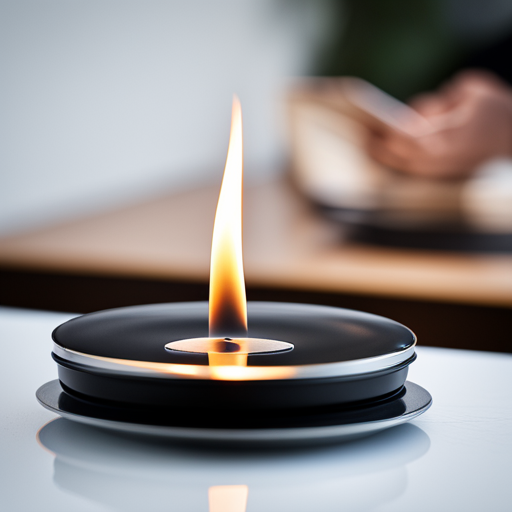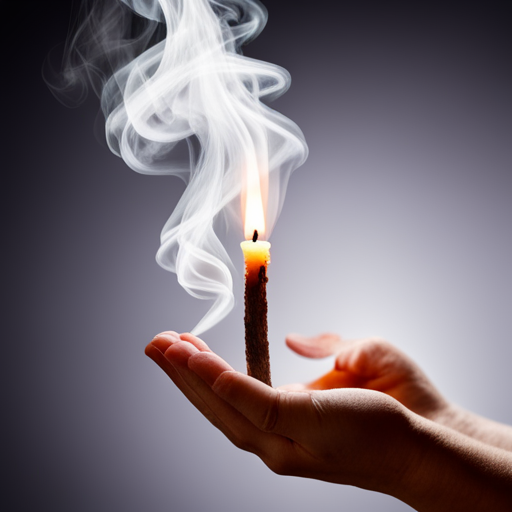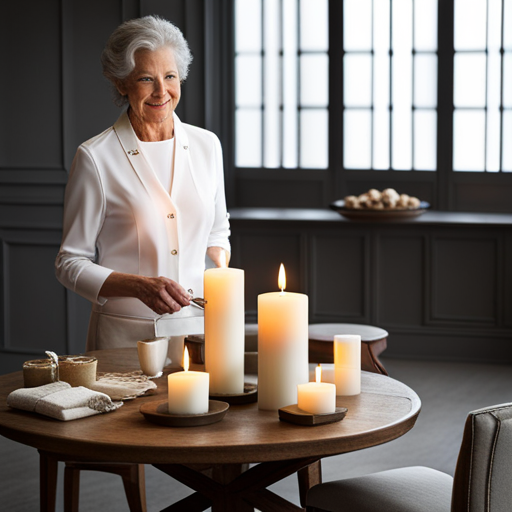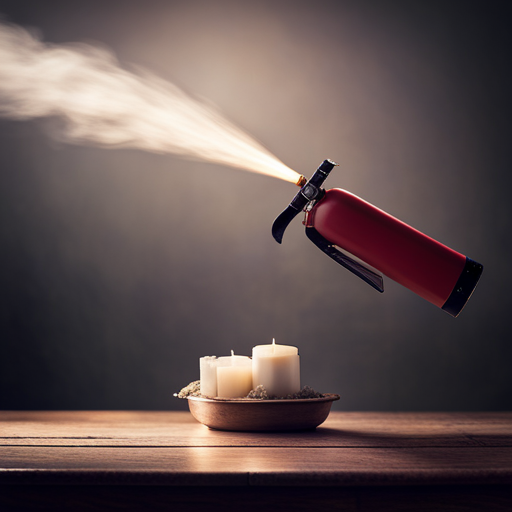To extinguish a candle without producing smoke, various methods can be used, such as a wick dipper or snuffer. Excessive smoke from candles can be caused by factors like long wicks or low-quality candles. Candle flickering, on the other hand, can be influenced by the size of the wick and drafts.
To improve indoor air quality, selecting cleaner-burning candles made from soy or beeswax and ensuring proper ventilation is essential.
Key Takeaways
– Burning scented candles in a well-ventilated area has minimal health effects.
– Smoke from candles, especially scented ones made from paraffin, can emit chemicals when burned.
– Breathing in candle smoke is not good for your health.
– The chemicals emitted by candles can be harmful, especially in large quantities.
The Importance of Smoke-Free Candle Extinguishing

https://www.youtube.com/watch?v=7dYbcBf6BRg
Extinguishing candles without producing smoke is important for maintaining good indoor air quality and reducing the release of harmful chemicals into the environment.
When candles are extinguished with smoke, it can contribute to the presence of indoor air pollutants, which can be detrimental to human health. Smoke from candles, especially those made from paraffin, can emit chemicals that are not good for breathing in large quantities.
Therefore, it is crucial to use methods that minimize smoke production when putting out candles. Some effective methods include using a wick dipper, suffocating the flame with a heat-resistant lid, or snuffing the candle with a candle snuffer.
Choosing the Right Method to Extinguish Candles Smoke-Free

To avoid the release of smoke, individuals can opt for alternative methods to safely and effectively end the burning of a candle. Here are four options to consider:
– Use a wick dipper: This method allows you to extinguish the flame without creating any smoke. Simply dip the wick into the melted wax and then lift it back up.
– Suffocate the flame: Placing a heat-resistant lid on the candle can cut off the oxygen supply, causing the flame to go out without producing any smoke.
– Snuff the candle: Using a candle snuffer is another smoke-free option. Gently place the snuffer over the flame to extinguish it.
– Wet your fingers: Wetting your fingers and quickly touching the wick can put out the flame without any smoke. However, be cautious of the heat and potential burns.
These methods provide a way to enjoy candles without the negative effects of smoke, allowing for a more pleasant and healthier environment.
Wick Dipping: A Smoke-Free Candle Extinguishing Technique

Dipping the wick into the melted wax allows for a smoke-free method of ending the burning of a candle. This technique involves submerging the wick into the liquid wax, which suffocates the flame and prevents the release of smoke. By extinguishing the flame in this manner, the candle can be put out without the usual plume of smoke that occurs when blowing out a candle.
Not only does this method eliminate the unpleasant odor and potential health risks associated with candle smoke, but it also helps maintain a clean and smoke-free environment. Additionally, dipping the wick into the wax can help prevent the wick from smoldering or creating a lingering smoke trail, ensuring a complete and safe extinguishment of the candle.
Heat-Resistant Lids: A Smoke-Free Solution for Extinguishing Candles

A heat-resistant lid placed on top of a lit candle suffocates the flame and prevents the release of smoke. This simple solution offers a smoke-free way to extinguish candles, minimizing the potential health effects associated with candle smoke. By using a heat-resistant lid, individuals can ensure that the candle is safely extinguished without the risk of smoke inhalation.
Benefits of using heat-resistant lids include:
– Eliminating the release of harmful chemicals and indoor air pollutants.
– Creating a cleaner and healthier indoor environment.
– Reducing the risk of respiratory issues caused by candle smoke.
– Promoting a safer method of candle extinguishing without the use of water or other potentially damaging methods.
With the use of heat-resistant lids, individuals can enjoy the ambiance and scent of candles without worrying about the negative effects of smoke.
Candle Snuffers: A Smoke-Free Alternative to Extinguish Flames

Placing a candle snuffer over a lit flame effectively extinguishes it without releasing smoke. This handy tool, typically made of metal or glass, works by cutting off the oxygen supply to the flame, causing it to go out quickly and cleanly.
Candle snuffers are designed with a bell-shaped or cone-shaped end that covers the flame completely, preventing any smoke or soot from escaping into the air. To use a candle snuffer, simply hold it above the flame and gently lower the snuffer until it covers the entire flame. Wait a few seconds to ensure the flame is completely extinguished before removing the snuffer.
This method is not only effective in putting out a candle, but it also helps maintain a smoke-free environment.
Wet Fingers: A Surprising Smoke-Free Method to Put Out Candles

Wetting their fingers, people can surprisingly extinguish a lit candle without releasing any smoke. This unconventional method may seem counterintuitive, but it is effective in preventing the unwanted release of smoke into the air.
By simply dipping their fingers in water before touching the flame, individuals can safely and efficiently put out the candle without causing any smoke to waft into the room. This technique offers a smoke-free alternative to traditional methods of extinguishing candles, such as using a snuffer or a lid.
With this simple trick, people can enjoy the warm glow of candlelight without worrying about the potential health effects associated with inhaling candle smoke.
– Quick and easy solution to extinguish a candle
– No need for additional tools or accessories
– Provides a smoke-free environment
– Promotes a healthier and cleaner indoor air quality
Causes of Excessive Smoke and How to Avoid It

After discussing the surprising smoke-free method of using wet fingers to put out candles, let’s now explore the causes of excessive smoke and how to avoid it.
Excessive smoke can be caused by a long wick or debris in the candle, such as dust and soot. Burning a candle for too long or using low-quality candles with excessive fragrance can also lead to more smoke.
To avoid excessive smoke, it is recommended to trim the wick before lighting the candle and choose high-quality candles made from soy-based or beeswax, as they burn cleaner. Additionally, avoiding drafts and properly ventilating the room can help reduce smoke.
Understanding Candle Flickering and Tips to Prevent It

Adjusting the location of the candle can help reduce flickering and create a more steady flame. This can be achieved by placing the candle in a draft-free area away from windows or fans.
Additionally, properly trimming the wick to a quarter of an inch can prevent flickering caused by an excessively long wick.
To further prevent flickering, it is important to keep the candle away from any impurities in the wax, such as soot or debris.
By taking these simple steps, one can enjoy a calm and tranquil ambiance without the distraction of a flickering flame.
– Adjust the location of the candle
– Trim the wick to a quarter of an inch
– Keep the candle away from impurities in the wax
– Create a calm and tranquil ambiance
Protecting Indoor Air Quality: Minimizing Candles’ Impact on Air Pollution

Burning soy-based or beeswax candles instead of paraffin wax candles can help minimize the impact of candles on indoor air pollution. These natural alternatives burn cleaner and produce fewer harmful chemicals when lit. The choice of wax used in a candle can greatly affect its impact on indoor air quality.
To evoke emotion in the audience, a 3×3 table can be used to showcase the differences between paraffin wax, soy-based wax, and beeswax candles. The table can include columns for ‘Wax Type,’ ‘Impact on Indoor Air Quality,’ and ‘Benefits.’
In the ‘Impact on Indoor Air Quality’ column, the table can highlight how paraffin wax candles release indoor air pollutants, while soy-based and beeswax candles burn cleaner.
The ‘Benefits’ column can emphasize the natural and healthier qualities of soy-based and beeswax candles, such as emitting fewer toxins and pollutants into the air.
Can Using Your Fingers to Put Out a Candle Cause Smoke?
Though a common trick, attempting to put out candle with fingers can cause smoke. The residue from your fingers can transfer to the wick and create excess smoke. It’s best to use a snuffer or gently blow on the flame instead for a cleaner result.
Frequently Asked Questions
Can the Smoke From Candles Be Harmful to Your Health?
Breathing in candle smoke is not good for one’s health. Scented candles made from paraffin can release indoor air pollutants that can be harmful, especially in large quantities.
What Are Some Common Causes of Excessive Smoke From Candles?
Excessive smoke from candles can be caused by a long wick, debris in the candle, burning for too long, low-quality candles, and paraffin wax. These factors can contribute to indoor air pollutants and health risks.
How Can You Prevent Candle Flickering?
To prevent candle flickering, one can adjust the location of the candle to reduce drafts, trim the wick properly, and ensure there are no impurities in the wax. These steps help create a steady flame.
What Are Some Tips for Choosing the Right Method to Extinguish Candles Without Smoke?
To choose the right method to extinguish candles without smoke, consider using a wick dipper, suffocating the flame with a lid, snuffing it with a candle snuffer, or wetting your fingers. Each method has pros and cons.
How Can You Protect Indoor Air Quality When Burning Candles?
To protect indoor air quality when burning candles, one should choose soy-based or beeswax candles, opt for natural scents, and ensure proper ventilation. The type of wax used in a candle can greatly impact its effect on indoor air quality.

